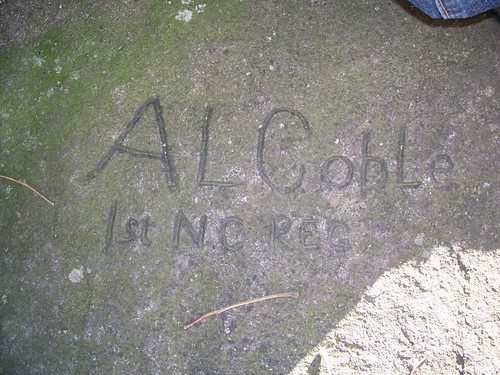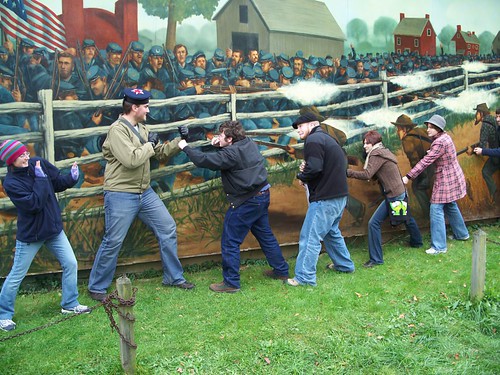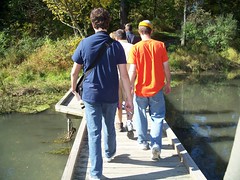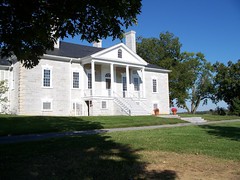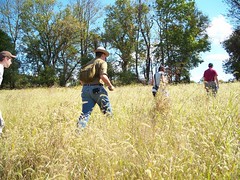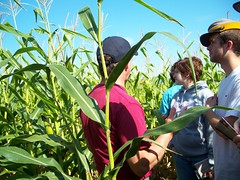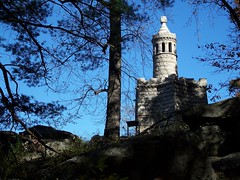 Our first stop was by the North Carolina monument on the Confederate lines. John used this position to lay out the Union and Confederate lines at the start of day two and gave us an overview of what happened in the course of the fighting. We began with the Union left and Sickles’ III Corps. We did a loop of the III Corps line starting at the Peach Orchard, then going to Little Round Top, and ending up in the middle by the Wheatfield.
Our first stop was by the North Carolina monument on the Confederate lines. John used this position to lay out the Union and Confederate lines at the start of day two and gave us an overview of what happened in the course of the fighting. We began with the Union left and Sickles’ III Corps. We did a loop of the III Corps line starting at the Peach Orchard, then going to Little Round Top, and ending up in the middle by the Wheatfield.
At Little Round Top John focused on the Union line at the face of the hill (since the 20th Maine is emphasized everywhere else) and we discussed the weak position of Sickles’ line in relation to the rest of the Union line. At the stony hill near the Wheatfield we were in the middle of Sickles’ line and heard about how the Union line began collapsing under the Confederates’ echelon attack. Then it was time for lunch at Pickett’s Buffet!
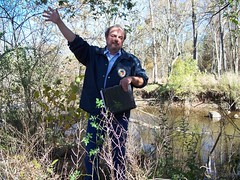 After lunch we headed to the center of the Union line on Cemetery Hill where Lee’s attack failed once it really started to work. We covered that briefly, and then moved to one of John’s favorite places-Culp’s Hill. We began on Benner’s Hill to see where the Confederate artillery was placed and where the infantry would make their attack from. Then we went to the other side of Rock Creek to the Union lines. John brought us to see one of the little known secrets of the battlefield- A.L. Coble from the 1st NC came back after the battle and carved his name in a rock where he had been fighting. We had to climb a huge rock to see it and unfortunately my roommate, Amy, fell and injured her ankle. We continued with the battle for Culp’s Hill and progressed over Steven’s Knoll to Cemetery Hill.
After lunch we headed to the center of the Union line on Cemetery Hill where Lee’s attack failed once it really started to work. We covered that briefly, and then moved to one of John’s favorite places-Culp’s Hill. We began on Benner’s Hill to see where the Confederate artillery was placed and where the infantry would make their attack from. Then we went to the other side of Rock Creek to the Union lines. John brought us to see one of the little known secrets of the battlefield- A.L. Coble from the 1st NC came back after the battle and carved his name in a rock where he had been fighting. We had to climb a huge rock to see it and unfortunately my roommate, Amy, fell and injured her ankle. We continued with the battle for Culp’s Hill and progressed over Steven’s Knoll to Cemetery Hill.
 After the bus scared us by turning its back up lights while five of us were still behind it (trying to help Amy hobble along) we crossed the road to finish up our tour with the battle for Cemetery Hill. Here another breakthrough occurred but was not supported and so Lee’s battle plans for July 2 failed. Then it was time to head back to the Appleford. We headed back to the bus but a low stone wall blocked our path. As Amy looked uneasily at the climb, Alex picked her up and started across the wall. Unfortunately he didn’t get very far as he slipped and fell (he was fine besides a few bruises). The afternoon ended as a “comedy of errors” with two more casualties of the Civil War.
After the bus scared us by turning its back up lights while five of us were still behind it (trying to help Amy hobble along) we crossed the road to finish up our tour with the battle for Cemetery Hill. Here another breakthrough occurred but was not supported and so Lee’s battle plans for July 2 failed. Then it was time to head back to the Appleford. We headed back to the bus but a low stone wall blocked our path. As Amy looked uneasily at the climb, Alex picked her up and started across the wall. Unfortunately he didn’t get very far as he slipped and fell (he was fine besides a few bruises). The afternoon ended as a “comedy of errors” with two more casualties of the Civil War.
Hopefully, our troops with have recovered by next week when we cover Day 3 and Pickett’s Charge!
-Katie Logothetis
